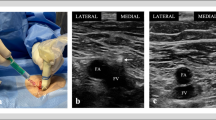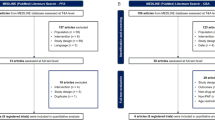Abstract
Background
Two important limitations of the data regarding the outcomes of catheter ablation of atrial fibrillation (AF) are the short-term follow-up used in most published studies and the lack of single-procedure outcomes.
Objective
The objective was to report the long-term single-procedure outcomes at our center.
Materials and methods
The patient population was comprised of 200 consecutive patients who underwent ablation (133 men; age 56 ± 11 years). Atrial fibrillation was paroxysmal in 92 (46%). Success was defined as absence of symptomatic AF, off antiarrhythmic drug (AAD) after a single procedure.
Results
After a follow-up of 26 ± 11 months, the single-procedure long-term success rate was 28% with an additional 7% of patients demonstrating improvement. After including repeat procedures in 64 patients, the overall long-term success rate was 41% with 11% demonstrating improvement. Further subgroup analysis of 48 paroxysmal AF patients considered to be optimal candidates for the procedure, revealed a long-term success rate of 69% with an additional 4% demonstrating improvement. A major complication occurred in 7.9% of patients.
Conclusion
The results reveal that the long-term single-procedure success rate of catheter ablation of AF in a cohort of patients with predominantly non-paroxysmal AF is less than 40%. The inclusion of redo procedures resulted in an improvement in outcomes. A much higher success rate of 69% was achieved in patients with paroxysmal AF considered to be optimal candidates for this procedure. These results make it clear that further advances in the technique of catheter ablation of AF are needed to improve the safety and efficacy of this procedure. In order to be able to compare outcomes of various techniques in differing patient populations, we urge investigators to report long-term single procedure outcomes.
Similar content being viewed by others
References
Bertaglia, E., Stabile, G., Senatore, G., Zoppo, F., Turco, P., Amellone, C., et al. (2005). Predictive value of early atrial tachyarrhythmias recurrence after circumferential anatomical pulmonary vein ablation. Pacing and Clinical Electrophysiology, 28, 366–371.
Cappato, R., Calkins, H., Chen, S. A., Davies, W., Iesaka, Y., Kalman, J., et al. (2005). Worldwide survey on the methods, efficacy, and safety of catheter ablation for human atrial fibrillation. Circulation, 111, 1100–1105.
Cauchemez, B., Extramiana, F., Cauchemez, S., Cosson, S., Zouzou, H., Meddane, M., et al. (2004). High-flow perfusion of sheaths for prevention of thromboembolic complications during complex catheter ablation in the left atrium. Journal of Cardiovascular Electrophysiology, 15, 276–283.
Chen, S. A., Hsieh, M. H., Tai, C. T., Tsai. C. F., Prakash, V. S., Yu, W. C., et al. (1999). Initiation of atrial fibrillation by ectopic beats originating from the pulmonary veins: Electrophysiological characteristics, pharmacological responses, and effects of radiofrequency ablation. Circulation, 100, 1879–1886.
Darbar, D, & Roden, D. M. (2005). Symptomatic burden as an endpoint to evaluate interventions in patients with atrial fibrillation. Heart Rhythm, 2, 544–549.
Dorian, P., Jung, W., Newman, D., Paquette, M., Wood, K., Ayers, G. M., et al. (2000). The impairment of health-related quality of life in patients with intermittent atrial fibrillation: Implications for the assessment of investigational therapy. Journal of the American College of Cardiology, 36, 1303–1309.
Dorian, P., Paquette, M., Newman, D., Green, M., Connolly, S. J., Talajic, M., et al. (2002). Quality of life improves with treatment in the Canadian Trial of Atrial Fibrillation. American Heart Journal, 143, 984–990.
FDA, US Department of Health and Human Services, and Center for Devices and Radiological Health. Clinical Study Designs for Percutaneous Catheter Ablation for Treatment of Atrial Fibrillation (Guidance for Industry and FDA staff). http://www.fda.gov/cdrh/ode/guidance/1229.pdf. 1-9-2004.
Gerstenfeld, E. P., Guerra, P., Sparks, P. B., Hattori, K., & Lesh, M. D. (2001). Clinical outcome after radiofrequency catheter ablation of focal atrial fibrillation triggers. Journal of Cardiovascular Electrophysiology, 12, 900–908.
Haissaguerre, M., Jais, P., Shah, D. C., Garrigue, S., Takahashi, A., Lavergne, T., et al. (2000). Electrophysiological end point for catheter ablation of atrial fibrillation initiated from multiple pulmonary venous foci. Circulation, 101, 1409–1417.
Haissaguerre, M., Jais, P., Shah, D. C., Takahashi, A., Hocini, M., Quiniou, G., et al. (1998). Spontaneous initiation of atrial fibrillation by ectopic beats originating in the pulmonary veins. New England Journal of Medicine, 339, 659–666.
Jais, P., Haissaguerre, M., Shah, D. C., Chouairi, S., Gencel, L., Hocini, M., et al. (1997). A focal source of atrial fibrillation treated by discrete radiofrequency ablation. Circulation, 95, 572–576.
Karch, M. R., Zrenner, B., Deisenhofer, I., Schreieck, J., Ndrepepa, G., Dong, J., et al. (2005). Freedom from atrial tachyarrhythmias after catheter ablation of atrial fibrillation: A randomized comparison between 2 current ablation strategies. Circulation, 111, 2875–2880.
Kok, L. C., Mangrum, J. M., Haines, D. E., & Mounsey, J. P. (2002). Cerebrovascular complication associated with pulmonary vein ablation. Journal of Cardiovascular Electrophysiology, 13, 764–767.
Kottkamp, H., Tanner, H., Kobza, R., Schirdewahn, P., Dorszewski, A., Gerds-Li, J. H., et al. (2004). Time courses and quantitative analysis of atrial fibrillation episode number and duration after circular plus linear left atrial lesions: Trigger elimination or substrate modification: Early or delayed cure? Journal of the American College of Cardiology, 44, 869–877.
MacLe, L., Jais, P., Weerasooriya, R., Hocini, M., Shah, D. C., Choi, K. J., et al. (2002). Irrigated-tip catheter ablation of pulmonary veins for treatment of atrial fibrillation. Journal of Cardiovascular Electrophysiology, 13, 1067–1073.
Mansour, M., Ruskin, J., & Keane, D. (2004). Efficacy and safety of segmental ostial versus circumferential extra-ostial pulmonary vein isolation for atrial fibrillation. Journal of Cardiovascular Electrophysiology, 15, 532–537.
Mantovan, R., Verlato, R., Calzolari, V., Baccillieri, S., De Leo, A., Turrini, P., et al. (2005). Comparison between anatomical and integrated approaches to atrial fibrillation ablation: Adjunctive role of electrical pulmonary vein disconnection. Journal of Cardiovascular Electrophysiology, 16, 1293–1297.
Marrouche, N. F., Dresing, T., Cole, C., Bash, D., Saad, E., Balaban, K. et al., (2002). Circular mapping and ablation of the pulmonary vein for treatment of atrial fibrillation: Impact of different catheter technologies. Journal of the American College of Cardiology, 40, 464–474.
O’Donnell, D., Furniss, S. S., Dunuwille, A., & Bourke, J. P. (2003). Delayed cure despite early recurrence after pulmonary vein isolation for atrial fibrillation. American Journal of Cardiology, 91, 83–85.
Oral, H., Chugh, A., Scharf, C., Hall, B., Cheung, P., Veerareddy, S., et al. (2004). Pulmonary vein isolation for vagotonic, adrenergic, and random episodes of paroxysmal atrial fibrillation. Journal of Cardiovascular Electrophysiology, 15, 402–406.
Oral, H., Knight, B. P., Ozaydin, M., Tada, H., Chugh, A., Hassan, S., et al. (2002). Clinical significance of early recurrences of atrial fibrillation after pulmonary vein isolation. Journal of the American College of Cardiology, 40, 100–104.
Oral, H., Knight, B. P., Tada, H., Ozaydin, M., Chugh, A., Hassan, S., et al. (2002). Pulmonary vein isolation for paroxysmal and persistent atrial fibrillation. Circulation, 105, 1077–1081.
Ouyang, F., Antz, M., Ernst, S., Hachiya, H., Mavrakis, H., Deger, F. T., et al. (2005). Recovered pulmonary vein conduction as a dominant factor for recurrent atrial tachyarrhythmias after complete circular isolation of the pulmonary veins: Lessons from double Lasso technique. Circulation, 111, 127–135.
Ouyang, F., Bansch, D., Ernst, S., Schaumann, A., Hachiya, H., Chen, M., et al. (2004). Complete isolation of left atrium surrounding the pulmonary veins: New insights from the double-Lasso technique in paroxysmal atrial fibrillation. Circulation, 110, 2090–2096.
Ouyang, F., Ernst, S., Chun, J., Bansch, D., Li, Y., Schaumann, A., et al. (2005). Electrophysiological findings during ablation of persistent atrial fibrillation with electroanatomic mapping and double Lasso catheter technique. Circulation, 112, 3038–3048.
Pappone, C., Oreto, G., Rosanio, S., Vicedomini, G., Tocchi, M., Gugliotta, F., et al. (2001). Atrial electroanatomic remodeling after circumferential radiofrequency pulmonary vein ablation: Efficacy of an anatomic approach in a large cohort of patients with atrial fibrillation. Circulation, 104, 2539–2544.
Pappone, C., Rosanio, S., Augello, G., Gallus, G., Vicedomini, G., Mazzone, P., et al. (2003). Mortality, morbidity, and quality of life after circumferential pulmonary vein ablation for atrial fibrillation: Outcomes from a controlled nonrandomized long-term study. Journal of the American College of Cardiology, 42, 185–197.
Pappone, C., Rosanio, S., Oreto, G., Tocchi, M., Gugliotta, F., Vicedomini, G., et al. (2000). Circumferential radiofrequency ablation of pulmonary vein ostia: A new anatomic approach for curing atrial fibrillation. Circulation, 102, 2619–2628.
Pappone, C., & Santinelli, V. (2001). Pulmonary vein isolation by circumferential radiofrequency lesions in atrial fibrillation. From substrate to clinical outcome. Ann Ist Super Sanita, 37, 401–407.
Shah, D., Haissaguerre, M., Jais, P., & Hocini, M. (2003). Nonpulmonary vein foci: Do they exist? Pacing and Clinical Electrophysiology, 26, 1631–1635.
Stabile, G., Bertaglia, E., Senatore, G., De Simone, A., Zoppo, F., Donnici, G., et al. (2006). Catheter ablation treatment in patients with drug-refractory atrial fibrillation: A prospective, multi-centre, randomized, controlled study (Catheter Ablation For The Cure Of Atrial Fibrillation Study). European Heart Journal, 27, 216–221.
Vasamreddy, C. R., Dalal, D., Eldadah, Z., Dickfeld, T., Jayam, V. K., Henrickson, C., et al. (2005). Safety and efficacy of circumferential pulmonary vein catheter ablation of atrial fibrillation. Heart Rhythm, 2, 42–48.
Vasamreddy, C. R., Jayam, V., Bluemke, D. A., & Calkins, H. (2004). Pulmonary vein occlusion: An unanticipated complication of catheter ablation of atrial fibrillation using the anatomic circumferential approach. Heart Rhythm, 1, 78–81.
Vasamreddy, C. R., Lickfett, L., Jayam, V. K., Nasir, K., Bradley, D. J., Eldadah, Z., et al. (2004). Predictors of recurrence following catheter ablation of atrial fibrillation using an irrigated-tip ablation catheter. Journal of Cardiovascular Electrophysiology, 15, 692–697.
Wu, R. C., Brinker, J. A., Yuh, D. D., Berger, R. D., & Calkins, H. G. (2002). Circular mapping catheter entrapment in the mitral valve apparatus: A previously unrecognized complication of focal atrial fibrillation ablation. Journal of Cardiovascular Electrophysiology, 13, 819–821.
Author information
Authors and Affiliations
Corresponding author
Additional information
This study was supported by The Norbert and Louise Grunwald Cardiac Arrhythmia Research Fund.
Rights and permissions
About this article
Cite this article
Cheema, A., Vasamreddy, C.R., Dalal, D. et al. Long-term single procedure efficacy of catheter ablation of atrial fibrillation. J Interv Card Electrophysiol 15, 145–155 (2006). https://doi.org/10.1007/s10840-006-9005-9
Received:
Accepted:
Published:
Issue Date:
DOI: https://doi.org/10.1007/s10840-006-9005-9




